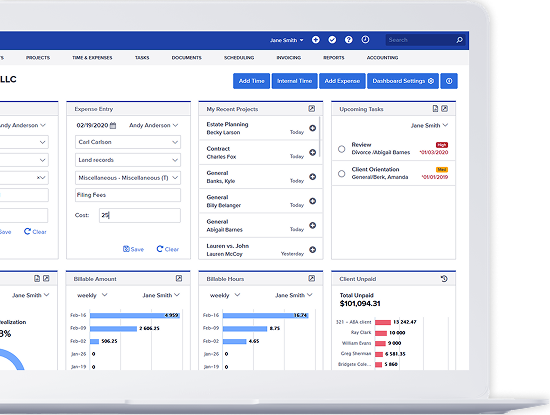
How Do Lawyers Charge Billable Hours?
09/24/2025 By Clare Sheehan
Lawyers charge for their services based on the time they spend on billable tasks for their clients. Unlike most professions, lawyers only bill for work on specific tasks. Some examples include:
- Client meetings
- Legal research
- Case development
- Document organization
- Court appearances
A lawyer’s invoice is meticulously broken down by tasks performed and the time spent, down to minute increments. Typically, this accounts for only a third of hours worked, with the rest of their time spent on administrative tasks or finding new clients.
Understanding billable hours offers valuable insights into your practice, including how you interact with your clients, effective communication practices, and the challenges your firm faces as a business. These challenges are even greater for small to mid-sized firms, which have fewer staff and fewer resources to allocate to non-billable tasks. Legal technology today aims to address these needs, from client management tools to attorney time and billing software.
For a law firm, billable hours present a unique challenge of balancing client needs with firm efficiency, clear communication, and preventing burnout. However, with proper systems in place, your firm can strike an appropriate balance that not only keeps your clients satisfied but also helps your business continue to grow.
Keep reading to learn more about the basics of billable hours and the benefits of using legal billing software for a solo practitioner or midsize firm.
What Are Billable Hours in a Law Firm?
Billable hours are the amount of time your firm spends on billable tasks. This time does not account for all the work your firm does, but only work that specifically addresses a client’s case. To distinguish between billable hours and actual hours, law firms must follow the standards of governing bodies, such as the American Bar Association (ABA), state regulations, and other best practices for billable hours.
What is a Billable Hours Chart?
A billable hours chart is a simple method to track your billing. Most often, attorneys bill by the hour and track time in 6-minute increments (0.1 hours), which is the industry standard. These charts support accuracy, help you avoid underbilling, and pair well with a law firm billable hours template.
We should note that manually tacking your hours leaves significant room for error. If you’d like to skip ahead to a solution that helps keep your billables on track without hassle, try Bill4Time for free!
Billing in 6-Minute Increments
| Minutes Worked | Decimal (Billable) |
| 1–6 | 0.1 |
| 7–12 | 0.2 |
| 13–18 | 0.3 |
| 19–24 | 0.4 |
| 25–30 | 0.5 |
| 31–36 | 0.6 |
| 37–42 | 0.7 |
| 43–48 | 0.8 |
| 49–54 | 0.9 |
| 55–60 | 1.0 |
Common Challenges in Law Firm Billing
Billable hours provide transparency for your clients, allowing them to see exactly how you are spending time on their case. But for law firms, especially a small law firm, a billable hours pay structure presents unique challenges, often related to accurate time tracking, clear client communication, and timely payment collection.
Accurate Time Tracking
Your time-tracking practices set the tone for the entire billing process. Unfortunately, billable hours are an inherently complex process, especially for law firms. Where most jobs simply “clock in and clock out,” attorneys are constantly shifting between different clients and billable tasks — all of which might have different hourly rates — resulting in a timesheet that is essentially like clocking in and out of multiple “jobs.”
Here’s a Solution: Bill4Time’s legal time tracking software is built specifically for this complexity. Whether you’re switching between calls, drafting documents, or reviewing discovery, you can start and stop timers from any device. Time entries can be assigned to specific clients, matters, and tasks — with predefined billing rates automatically applied. No spreadsheets. No reconstruction of your day at midnight.
You can even convert appointments and completed tasks into billable entries in one click. That kind of workflow turns what used to be a hassle into second nature.
Clear Client Communication
One of the main reasons lawyers default to billable hours today is to improve client relationships, primarily through transparency. Client trust is a universal issue in the legal industry, and even though most law firms are aware of this issue, some may not be aware of how big the gap in consumer trust is.
A 2024 industry report found that while 90 percent of businesses believe their clients trust them, only 30 percent of clients actually do — and this is for businesses overall.
Law firms have the added challenge of dealing with complex client issues, navigating nuanced standards and keeping a meticulous record of what they work on. When clients see vague time entries or broad task descriptions, they don’t just get confused — they start questioning your work. That trust gap? It’s real.
Here’s a Solution: Bill4Time bridges that with detailed, customizable invoicing that spells out exactly what was done, for whom, and when. You can write clear narrative descriptions for each task, include supporting documents, and choose how much detail each client sees. Everything is date-stamped and linked to the right project.
That transparency lets your invoice speak for itself. Clients get clarity without back-and-forth emails. You get fewer disputes and stronger relationships.
Timely Payment Collection
All law firms, both big and small, know the challenge of getting paid. And while it’s easy to blame the clients for not sending in payment fast enough, a lot of the delay between work and payment comes from the billing process itself. Whether it’s complicated timesheets, a slow invoice creation process, or back-and-forth disputes with clients about their invoice’s details, little delays compound over time, especially when you’re handling a full caseload. With tasks that are universal to every client (such as billing or intake), what may seem like a small hiccup can become a huge loss in revenue when you’re facing the same issues over and over.
Here’s a Solution: With Bill4Time, you can generate and send invoices instantly, then accept payments online through integrated credit card and ACH processing. Clients receive secure links, can view invoices on any device, and pay in minutes. No need to print, scan, or chase them down.
You also get automatic payment reminders and real-time tracking of what’s outstanding. The result: fewer delays, less follow-up, and more time spent on billable work.
How To Improve Your Law Firm’s Billing Process
For the average law firm, billable hours provide a whole host of challenges, but these challenges can be addressed with the right systems in place. If you’re looking to improve your billing process, start by addressing these four cornerstones of a good billing process:
- Technology accelerates payment.
- Timing maximizes impact.
- Tracking improves performance.
- Convenience empowers clients.
Let’s take a look at each of these cornerstones individually.
- Technology Accelerates Payment | Using modern technology is not just a matter of following trends or “getting with the times.” Technology like legal billing software offloads much of the time-consuming, repetitive tasks that take away time and energy from attorneys, whose time is already split between a myriad of tasks. Not only that, but consumer data shows clients are much happier to pay via online payment portals.
- Timing Maximizes Impact | While it’s generally best practice to invoice at the end of the month, a good invoice schedule is really about consistency: sending your invoice at the same time, without fail. Automation can help with the actual “sending,” but smoothing out your process for recording hours lets you quickly draft invoices. If getting paid sooner somehow isn’t compelling enough (which we doubt), consider this: according to the ABA, research shows that the longer you take to log billable hours, the less billable time you’ll remember. In this case, “time is money” becomes quite literal. Time lost in the billing process results in revenue lost for your business.
- Tracking Improves Performance | We’ve discussed tracking billable time extensively, but that’s not the only type of time tracking that can make or break your billing process. How much of your time is spent on billable tasks? How much time does it take you to generate an invoice? And speaking of invoices, how many outstanding ones do you have currently, and what percentage of total revenue do they represent? These are just a few of the questions that detailed tracking can solve — and legal billing software can help fill those gaps.
- Convenience Empowers Clients | Earlier, we talked about how clients prefer to pay through online portals, and convenience is the reason why. But convenience is also a powerful motivator for customers. As you structure your billing and invoicing process, consider how the client experiences that process. How many payment options do you have? Where can they go if they have questions about invoice details? Is everything on the invoice laid out so they can understand it without your help?
Make Billing Simple: Try Bill4Time
If you’re a small to mid-sized law firm, your billable hours process is crucial to your success. No matter what your specialty is, all firms have to handle billing, and the smaller your headcount is, the more essential it is to have an efficient system that works with your practice. Ready to take the next step in upgrading your billing process? Try Bill4Time for free or sign up for a free demo!



